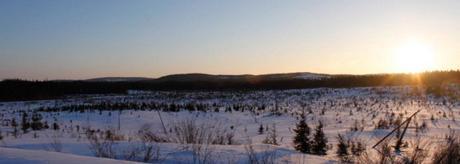
A clear-cut area is seen in Canada’s Broadback Valley, one of the last remaining virgin boreal forest of Quebec, on March 12, 2014. The Indian Cree community of Waswanipi, Canada is fighting to protect 13,000 square kilometers of forest north of their village in the Broadback Valley from the logging industry that keeps pushing its way further north. Photo by Clement Sabourin/AFP
by Clement Sabourin / Agence France-Presse
BROADBACK VALLEY, Canada – Beyond a clear-cut in Quebec’s far north – marked by a sign that reads “the road of destruction ends here” – aboriginal Canadians are fighting for an ancient forest and their traditional hunting rights.
Canada’s boreal forest is the largest intact forest in the world, comprising one-third of the forest circling the North Pole above the 50th parallel.
In this remote part of Quebec province, just south of the frozen Broadback River, the coniferous forest is home to hundreds of wildlife species including the endangered woodland caribou.
For centuries, Cree tribesmen have also lived and hunted in these woods.
They lived without hindrance until the 1970s, when logging and the construction of hydro-electric dams in the James Bay region started to encroach on them.
In 2010, a dozen Cree tallymen – tasked with supervising trapline activities — decided to take a stand on behalf of 16,000 Cree who live in this area, and blocked logging roads in protest.
They say logging offers few benefits to indigenous people, while damaging the environment.
The sign on a dirt road 6 kilometers (4 miles) south of the river represents their last stand.
They have demanded that some 13,000 square kilometers (5,020 square miles) of wilderness north of the marker be set aside for a nature preserve.
Forestry companies had agreed to a logging moratorium but that expired last June, and the Grand Council of the Crees has yet to reach an accord with the Quebec government.
Election issue
The future of the forest is an issue in the province’s general election.
The Liberal Party, which is leading in the polls, favors massive exploitation of untapped natural resources in Quebec’s far north.
Liberal leader Philippe Couillard said on the campaign trail that “thousands of jobs, millions of cubic meters of wood and (several) pulp mills are at stake.”
The Liberals’ main rival, the Parti Quebecois, has also pledged to significantly boost logging in the province over the coming years.
“At least they haven’t started handing out exploitation permits yet,” said Steven Blacksmith, the natural resources administrator for the Cree reserve of Waswanipi.
According to the latest government figures, Quebec’s forestry industry is the largest in the country, employing close to 70,000 people.
The industry accounts for 2.7 percent of the province’s gross domestic product, exporting billions of dollars worth of lumber, pulp and paper each year.
But it has struggled with every up and down of the global economy.
Cree culture at stake
Standing in the middle of a logged section of his former trapline, Don Saganash points in every direction and laments: “We can’t hunt here; the animals don’t have any shelter anymore.”
“We can’t even trap marten anymore,” echoes his cousin Malcolm. “This winter I caught none, whereas before I would catch 100.”
Hunting is not just for sustenance or sport but at the heart of Cree culture, and has been recognized in Canadian law as a right for natives nationwide.
But those rights are being tested by lumberjacks pushing further and further north, Don says.
From time to time, forestry industry representatives stop in at Don, Malcolm and another cousin Philippe’s hunting camp deep in the woods to announce plans for logging nearby, and offer the trio compensation.
“I say no, but they still move forward,” says Malcolm.
Philippe said there were now three forestry companies on his land – traditional Cree territory.
“They never ask (for permission). They don’t care about what we think,” he says.
Winters here are growing shorter, and caribou are becoming scarcer due to forest clear-cutting and more and more predatory wolves finding their way north along logging roads.
Cree fear they are witnessing the twilight of their ancestors’ way of life.
Huddled around a wood-burning stove to cook moose meat in the Cree village of Waswanipi, about 200 kilometers (120 miles) south of the Saganash cousins’ log cabin, Cree elders are unanimous.
“The water, the fish, the meat (in the region) doesn’t taste the same anymore,” says Alice Happyjack. “I feel sad.”
With heavy eyelids, Joseph Neeposh explains in a Cree drawl that he has lived all of his life in the forest and that Cree have a “spiritual connection” to the land.
“Destroying the forest is destroying us.”

